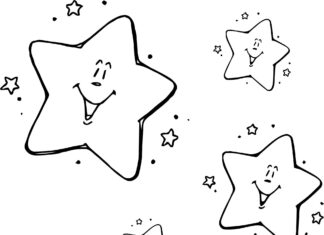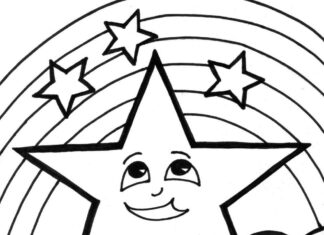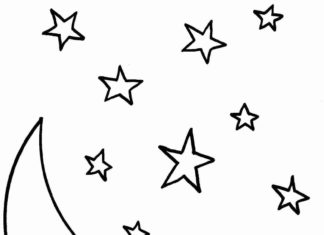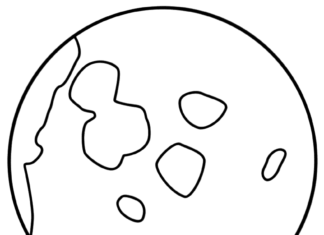We can observe the Moon in the sky since the evening, when it slowly starts to get dark. Its characteristic surface can be viewed from the ground with a telescope and it makes an incredible impression. The celestial body to which the first human journey took place in 1969. If you want to color this type of picture you can find the one you like the most, choose the colors and start working.
Coloring Pages Moon and Stars
Information
Moon:
- Natural satellite: The moon is a natural satellite of the Earth. This means that it orbits around our planet. It is the only natural satellite of the Earth.
- Phases of the Moon: The Moon goes through different phases, from New to Full. This phenomenon is due to the different visibility of the Moon's illuminated surface depending on its position relative to the Earth and the Sun.
- Tidal influence: The gravitational interaction between the Moon and the Sun affects ocean tides. This phenomenon is called tides, which have a major impact on aquatic life and the coastal environment.
- Space exploration: Mankind has conducted many space missions to explore the Moon. The first man on the moon was Neil Armstrong during the Apollo 11 mission in 1969.
- Cultural impact: The moon has played an important role in human culture for centuries. It has often been associated with myths, legends and beliefs of various cultures around the world.
Stars:
- Stars as suns: Stars are hot, selfish gas clouds that glow due to thermonuclear reactions inside them. Our Sun is one of the stars.
- Variety of stars: Stars vary in mass, temperature, brightness and color. It all depends on their evolutionary stage and chemical composition.
- Constellations: The stars in the sky form various constellations - imaginary images that different cultures have assigned to the stars to create stories and mythologies.
- Life expectancy: The mass of stars determines their lifespan and final fate. Stars can transform into red giants, and larger ones end their lives as supernovae or black holes.
- Starlight: What we see as "starlight" is actually electromagnetic radiation, which can be of different colors depending on the temperature of the star's surface.
Trivia
Moon:
- Tidal influence: The gravitational influence of the moon affects ocean tides. This phenomenon creates tidal cycles that are important for coastal ecosystems.
- Without atmosphere: The moon has no atmosphere, which means there is no air on its surface, protecting it from cosmic radiation and wind.
- Earth's tidal force: The Moon's gravitational interaction with the Earth causes the Earth to "deform" slightly. This phenomenon is called tidal force.
- The dark side of the moon: It is often said that the "dark side of the Moon", but in fact both sides receive an equal amount of sunlight. This is related to the fact that the Moon rotates around its axis at such a rate that it always shows the same side of the Earth.
- Rocky and full of craters: The Moon's surface is rocky and covered with numerous craters. Many of them were formed by impacts of small celestial bodies.
Stars:
- Variety of colors: Stars have different colors, which depend on their temperature. Red stars are cooler and blue stars are hotter.
- Glow and distance: The brilliance of stars is not always related to their distance from Earth. Often it is a result of their brightness and temperature.
- Starlight is a thing of the past: What we see as starlight is actually past, because the light has to travel the distance between the star and the Earth.
- Sun-like stars: The Sun is a G-type star, and stars similar to it make up about 90% of the stars in the galaxy.
- Pulsating stars: Some stars pulsate, changing their brightness in a regular cycle. These are known as variable stars, which can provide information about their interiors.
- The brightest star in the sky: Sirus, located in the constellation of the Big Dog, is the brightest star visible in the night sky.
- Triple stars: There are triple stars, consisting of three stars bound by gravity. Sometimes they can be seen as a single point source of light.
- History of stars in culture: Stars played a key role in maritime and land navigation. People used their positions to determine directions and time.
- Our body is stellar: Did you know that the atoms in our bodies were formed inside stars? It was thanks to thermonuclear reactions that heavier elements were created, which later gave rise to our solar system.
- Transient stars: Depending on their mass, stars can go through different phases of evolution, including red giants, which are the last stage in the life of stars with smaller masses.











